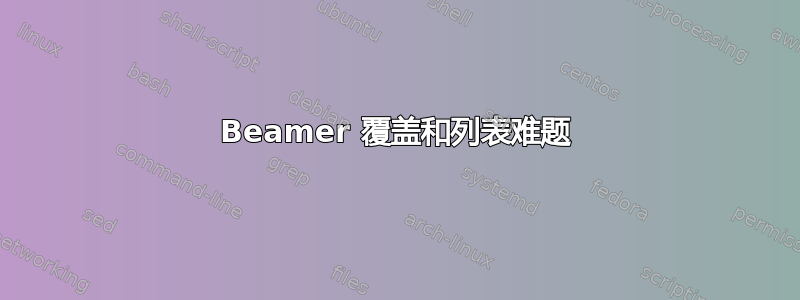
当我尝试lstlisting用转义字符覆盖 C 代码(以便我可以插入\colorbox)时,出现以下错误:
! Missing number, treated as zero.
<to be read again>
\let
l.15 }
请参阅下面的一些beamer重现错误的代码。请注意,如果我注释掉覆盖指令(请参阅% comment this我的代码中的注释读数),代码将编译并完美运行。
我希望覆盖层能够在我的lstlisting环境中运行。有没有什么线索可以解决这个问题?
\documentclass[smaller]{beamer}
\usepackage{graphicx}
\usepackage{color,xcolor}
\usepackage{boxedminipage}
\usepackage{listings}
\usepackage{pgf,pgfpages}
\usepackage{tikz, subfig}
\usetikzlibrary{arrows,shapes,positioning}
\usetheme{boxes}
\usefonttheme[stillsansseriftext,stillsansserifsmall]{serif}
\setbeamerfont{frametitle}{size=\large,series=\bfseries,shape=\sf}
\definecolor{red} {rgb}{.8,0,0}
\definecolor{blue} {rgb}{0,0,.9}
\begin{document}
\begin{frame}[fragile]
\frametitle{C Program}
\only<1>{ % comment this
\begin{minipage}{\textwidth}
\begin{minipage}{0.5\textwidth}
\begin{lstlisting} [language=C,keywordstyle=\color{red},escapechar=\!,basicstyle=\ttfamily\scriptsize]
!\colorbox{blue}{x++;}!
\end{lstlisting}
\end{minipage}
\begin{minipage}{0.5\textwidth}
\begin{lstlisting}[language=C,keywordstyle=\color{red},escapechar=\!, basicstyle=\ttfamily\scriptsize]
!\colorbox{red}{y++;}!
\end{lstlisting}
\end{minipage}
\end{minipage}
} % comment this
\only<2>{ % comment this
\begin{tikzpicture}[font=\footnotesize]
\node at (0,0) {$P_M$};
\node at (1,0) {$P_{W_1}$};
\node at (2,0) {$P_{W_2}$};
\draw (-1,-0.3) -- (3,-0.3);
\end{tikzpicture}
} % Comment this
\end{frame}
\end{document}
答案1
以下是一些重现错误的最少代码。
\documentclass{beamer}
\usepackage{listings}
\begin{document}
\begin{frame}[fragile]
\only<1>{
\begin{lstlisting}
\colorbox{blue}{x++;}
\end{lstlisting}
}
\end{frame}
\end{document}
如果删除覆盖宏 ( \only),代码可以正常编译。这说明问题与 无关escapechar。相反,问题似乎在于\only不理解逐字内容(lstlisting在本例中是您的环境)。
一种解决方法是将您的列表放在外部文件中,然后使用\lstinputlisting; 插入它们,见下文。
附注:beamer提供了两个环境columns和column,它们比minipage这里的 更符合习惯用法。请使用它们。

\documentclass[smaller]{beamer}
\usepackage{graphicx}
\usepackage{color,xcolor}
\usepackage{boxedminipage}
\usepackage{listings}
\usepackage{pgf,pgfpages}
\usepackage{tikz, subfig}
\usetikzlibrary{arrows,shapes,positioning}
\usepackage{filecontents}
\usetheme{boxes}
\usefonttheme[stillsansseriftext,stillsansserifsmall]{serif}
\setbeamerfont{frametitle}{size=\large,series=\bfseries,shape=\sf}
\definecolor{red}{rgb}{.8,0,0}
\definecolor{blue}{rgb}{0,0,.9}
\begin{filecontents*}{samplex.c}
!\colorbox{blue}{x++;}!
\end{filecontents*}
\begin{filecontents*}{sampley.c}
!\colorbox{red}{y++;}!
\end{filecontents*}
\lstdefinestyle{myC}
{
language=C,
keywordstyle=\color{red},
escapechar=!,
basicstyle=\ttfamily\scriptsize,
}
\begin{document}
\begin{frame}[fragile]
\frametitle{C Program}
\only<1>{
\begin{columns}
\begin{column}{.5\textwidth}
\lstinputlisting[style=myC]{samplex.c}
\end{column}
\begin{column}{.5\textwidth}
\lstinputlisting[style=myC]{sampley.c}
\end{column}
\end{columns}
}
\only<2>{
\begin{tikzpicture}[font=\footnotesize]
\node at (0,0) {$P_M$};
\node at (1,0) {$P_{W_1}$};
\node at (2,0) {$P_{W_2}$};
\draw (-1,-0.3) -- (3,-0.3);
\end{tikzpicture}
}
\end{frame}
\end{document}
答案2
替换\only<1>{...}为\begin{onlyenv}<1>...\end{onlyenv}使用里面的逐字代码:
\documentclass[smaller]{beamer}
\usepackage{graphicx}
\usepackage{color,xcolor}
\usepackage{boxedminipage}
\usepackage{listings}
\usepackage{pgf,pgfpages}
\usepackage{tikz, subfig}
\usetikzlibrary{arrows,shapes,positioning}
\usetheme{boxes}
\usefonttheme[stillsansseriftext,stillsansserifsmall]{serif}
\setbeamerfont{frametitle}{size=\large,series=\bfseries,shape=\sf}
\definecolor{red} {rgb}{.8,0,0}
\definecolor{blue} {rgb}{0,0,.9}
\begin{document}
\begin{frame}[fragile]
\frametitle{C Program}
\begin{onlyenv}<1>
\begin{minipage}{\textwidth}
\begin{minipage}{0.5\textwidth}
\begin{lstlisting} [language=C,keywordstyle=\color{red},escapechar=\!,basicstyle=\ttfamily\scriptsize]
!\colorbox{blue}{x++;}!
\end{lstlisting}
\end{minipage}
\begin{minipage}{0.5\textwidth}
\begin{lstlisting}[language=C,keywordstyle=\color{red},escapechar=\!, basicstyle=\ttfamily\scriptsize]
!\colorbox{red}{y++;}!
\end{lstlisting}
\end{minipage}
\end{minipage}
\end{onlyenv}
\begin{onlyenv}<2>
\begin{tikzpicture}[font=\footnotesize]
\node at (0,0) {$P_M$};
\node at (1,0) {$P_{W_1}$};
\node at (2,0) {$P_{W_2}$};
\draw (-1,-0.3) -- (3,-0.3);
\end{tikzpicture}
\end{onlyenv}
\end{frame}
\end{document}


